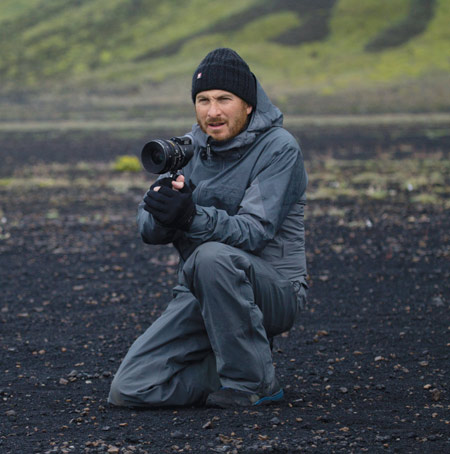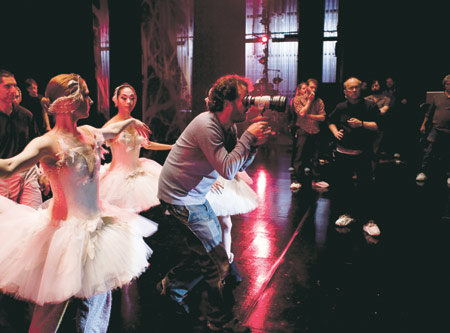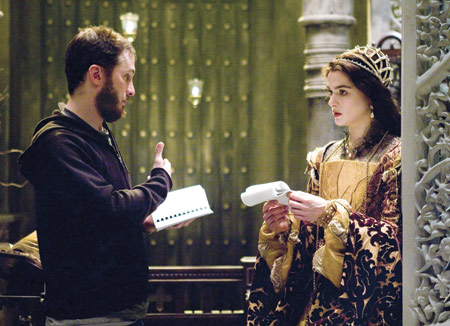By JOHN ANDERSON

END OF THE WORLD: Aronofsky at work on Noah in Iceland. For a complex CGI film like this with so many moving parts, he says you have to trust your collaborators and have faith it will all come together.
Last year, on the fabled Gold Coast of Long Island, sat a movie prop of biblical proportions. Or close enough.
“There are lots of different kinds of cubits,” director Darren Aronofsky explains, referring to the ancient measurement described in the Bible, and by which one can size up the one-third of a very big boat that was built for Noah, his upcoming epic about the man who saved mankind and the animal kingdom from the mother of all floods. “There’s an Egyptian cubit, a Roman cubit, a Hebrew cubit. We got a general sense of what the cubit is and we were pretty spot on to the measurements and the descriptions in the Bible of what the Ark looked like—75 feet-by-55 feet-by-450 feet, something like that. But don’t quote me.”
It was a pretty special effect, conjured up by a director who’s been striving to create special effects even before he had the technologies available, or the money to buy them. In Pi (1998), his debut feature about a pill-popping math genius caught between the Talmud and a hard place, the manipulation of the 16 mm black-and-white images and the measured, rhythmic intercutting of druggy set pieces, caused the film to burst out of the pack when it debuted at the Sundance Film Festival. Aronofsky received the Directing Award, and his technique got a label.
“Hip-hop montages,” the director acknowledged. “When I was at college, I was experimenting with that idea and I think it came out of the fact I grew up in Brooklyn in the ’80s, when hip-hop was exploding, and I was trying to fuse the idea of sampling to storytelling.” What he came up with were quickly edited visual collages that showed the protagonist ingesting pharmaceuticals, and which could be shown, with adjusted frequency, to reflect the hero’s mental state. The riffs weren’t high-tech by today’s standards, but they helped create a language for the film and, like any musical motif, ultimately carried their own message, or modified whatever else was happening onscreen.
It was a style Aronofsky would refine and repeat in Requiem for a Dream (2000), a harrowing drama of addiction based on the novel by Hubert Selby Jr. He started “playing” with the technique, which led to the various hallucinations that systematically erupt in the picture. “I got excited about it on Requiem,” Aronofsky says, “when I looked at the repetitive behavior that marks addiction, and I thought, ‘Oh, this will be a really good way to show people getting high without actually having to fetishize the process.’”
If not exactly fetishistic, Requiem’s close-ups of percolating hypodermics and engorged junkie veins now seem like a natural progression from what directors such as Martin Scorsese were doing around the same time. (In Casino, for instance, close-up grains of cocaine swirl up a straw and into a nostril.) “It might have been in the air,” Aronofsky admits. “But I think Bob Fosse was doing it before any of us. If you look at All That Jazz, which I saw as a little kid—for some reason my parents took me to see it—maybe it was in the back of my head.”
Getting inside someone’s head—his own, maybe, but certainly his characters’—has been a signature of Aronofsky’s work. When it was suggested that he’s obsessed with obsession, he demurred.
 IN RHYTHM: Aronofsky weaves among the dancers on Black Swan.
IN RHYTHM: Aronofsky weaves among the dancers on Black Swan. “I’m not good with that self-analysis sort of thing,” he says, with a sort-of smile. “I just try to tell stories, and I guess I push them in that direction, but I don’t think about why that is. I’m usually in the character’s head, trying to follow some form of their psychology.
“It’s all about research,” he continues, “understanding their world and putting yourself in their head and figuring out what you would do.” On The Wrestler (2008), for instance, he met and talked with wrestlers and journalists who cover the sport. “It’s like anything, you want to drown yourself in information.” He didn’t wrestle, of course, although at the end of the shoot, Mickey Rourke made him jump off the ropes. “I had neck pains for about half a year.”
While Aronofsky avoids self-analysis, he recognizes at the same time a creative trajectory that began for him as an undergrad at Harvard, where the director, now 44, studied social anthropology and film.
“I wasn’t a big fan of social anthropology,” he says. “And, luckily, that created room for me to work in visual arts because I sort of ignored my requirements. I think I was attracted to social anthropology because I liked to travel and was always interested in far-off places. When you grow up in Brooklyn, at least back when I grew up in Brooklyn, all you wanted to do was get the fuck out.”
Harvard, of course, offered the young Brooklynite something else entirely, including an introduction to basic cinema.
“Our training in the first-year film class started out with documentary films,” he says. “They gave you a couple of rolls of Tri-X and said, ‘Go make a film about one person.’ When I did Pi I went back to those roots—I brought fiction into it, but the idea was one actor, one character, and that character’s world.
“We were trying to bring a thriller narrative into it,” he says of Pi, “but still, it was sort of based on one character. And if you look at my films, including The Wrestler and Black Swan, they have that ethnographic approach to entering these characters’ worlds and trying to make a documentary-like, cinéma vérité-like film.”
With the exception of The Wrestler, which was shot by Maryse Alberti, Aronofsky has made each of his features with DP Matthew Libatique, whom he met in the early ’90s when they were students at the AFI Conservatory. Although they are obviously artistically compatible, there is no set process for how they arrive at a shooting strategy.
“It depends,” Aronofsky says. “Pi, for instance, had a very controlled film grammar. We thought long and hard about how to limit our palette to tell a simple story, partly because resources were incredibly limited. And we had to decide how to make those limits our strengths.”
The whole shooting style—one of the film’s distinguishing features—arose from need. “It was very basic stuff: Every time you moved the camera it cost you time and money, so we reused locations as much as possible,” Aronofsky says. “We could always count on one actor [Sean Gullette] showing up every day, so we made it a film largely about one character.”

(above) Working with Rachel Weisz on The Fountain and (below) Mickey Rourke on The Wrestler.

The same ethos informed the higher budgeted Requiem to a larger degree. And even on The Fountain (2006), the phantasmagorical/allegorical fantasy that encompassed history, religion, cancer research, science fiction, imperial Spain and outer space—there was nothing in the film that couldn’t be photographed. “All the space effects were later manipulated digitally,” Aronofsky says, “but they all started out as something photographic. At the time I felt that most digital effects were dating pretty quickly and once three or four years went by, you’d see right through them.”
The shifts that Aronofsky and his team—notably, Libatique and production designer Mark Friedberg—have experienced on Noah are tectonic. And yet he says he feels that “if anything, the director has more control over everything. Increasingly, the images are coming out of a computer, but that means you can change anything and have more control.”
As one might expect, there are major CG effects in Noah. “There are fantastical creatures, fantastical events,” says Aronofsky. “There’s a huge deluge. What you’re photographing is often not the thing that will appear on screen—that’s the underpinning. There will be a huge amount of visual architecture placed on top of that, and that sort of makes it a different job. Sometimes only the actor’s face will be in the final image.”
It’s a different kind of filmmaking, he says—to imagine what something might become—and “have faith that your collaborators are going to breathe life into what you aren’t photographing. You have to trust that down the road things are going to come alive.” To ensure that they do, he says, required a huge amount of preparation.
There are no live animals on Noah, which was shot in New York and Iceland; everything living that’s non-human is rendered digitally. “We had to create an entire animal kingdom,” says Aronofsky. “All the animals in the movie are slightly tweaked; I didn’t want the clichéd polar bear, elephant, and lion walking onto the Ark; I didn’t want the shot of a giraffe’s head looking over the rail. I wanted to respect the storyline and think what would have been involved if it all really happened.”
In collaboration with Industrial Light & Magic (ILM), “We basically went through the animal kingdom and pinpointed the body types we wanted: some pachyderms, some rodents, reptiles, and the bird kingdom. We chose the species and they were brought to life with different furs and colors. We didn’t want anything fully recognizable but not completely absurd either.”
Around the time of this interview, Aronofsky was told by ILM that they had just done the most complicated rendering in the company’s history involving the animals on the Ark.
“It was a nice badge of honor,” he smiled. “I don’t think it’s the most incredible shot, but I think because of all the hair on the animals it was incredibly complicated for them. They said, ‘We can only render it two or three more times so make sure those are exactly right because they take so long and are so complex.’”
The decision not to use real animals was easy. “I think we’ve learned from people who have done it before that that’s a really bad move,” he says. “Politically it’s not a great thing to work with live animals and that’s becoming more apparent to people as time goes by, but also, technically, it would have been extremely difficult. And we’ve learned from lots of other films how hard it is to bring different kinds of animals together.” (As in clashing species or animals that might decide to eat their co-stars.)
Throughout his career Aronofsky says he’s been well served “by a good combination of ambition and naiveté,” as well as passion for good material. “When I was finishing up Pi, a black-and-white movie that was shot on 16 mm, I had no freaking clue what was ahead of me. But with my ignorance I sort of had the bravery to give it a shot. So I don’t think it was much different after Black Swan to jump into a film on the scale of Noah.”
The film that Aronofsky almost made after The Wrestler was The Fighter, which was ultimately directed by David O. Russell, who was nominated for a DGA Award. “You have to develop a lot of different things because you don’t know how things are going to turn out,” says Aronofsky. “For me it’s like a marathon—a lot of different runners at the starting line, but you don’t know who’s going to finish, and the finish line is when the script’s ready to shoot. I heard the story of The Fighter and it was clear to me that it was an amazing true-life story. We worked on it for a long time and then I ended up doing The Wrestler, and by the time I was finished with The Wrestler I was like, ‘You know what? I’m kinda done with men in tights and the smell of Bengay in my nose.’ I just wanted to do something very, very different.”
Like women in tights?
“Yeah,” he conceded. “But less Bengay.”
While Black Swan (2010), for which Aronofsky received a DGA Award nomination, seems, on the surface, like the furthest thing from a movie starring Mickey Rourke as Randy “The Ram” Robinson, the director disagrees.
“The Wrestler and Black Swan were both very first-person, character-driven stories,” he says, “so I was trying to find a similar way to get the audience into their world and characters. Very early on with The Wrestler we had the idea ‘OK, let’s hide our protagonist for a while,’ and this grew into the conceit of being with the character as he takes you to different places.” Hence the trailing camera and shots of Randy’s back as he travels through the physical world of low-rent professional wrestling. On “the ballet movie,” as Aronofsky calls it, “we said, ‘Let’s see how the same thing works in this world.’”
According to Aronofsky, Black Swan enjoyed a more formal and controlled film language, but it also had a much stronger narrative line. “I always thought of Black Swan as an alternative take on Swan Lake,” he says. “And if you line up what happens in the ballet Swan Lake, we make direct connections to what was happening in the movie Black Swan. So when it was time to do a dance sequence we would have a sense of where it fit in the timeline of Swan Lake, and we would be able to choose which music we wanted for what was happening, narratively, in the story.”
Then, he says, Benjamin Millepied, the film’s choreographer, would go out and start putting together a reinterpretation of what the classical ballet had done with the story and “make it our horror version of that.”
At that point, “Matty and I would go in with a video camera and literally start dancing, taking turns with the camera, moving with the dancers; he would shoot one, I would shoot a few, and he would adapt to what I did, and we would get a sense of it.”
On the set itself, with all the other actors and dance corps, “We’d have to refigure how the camera weaved in and out and then the operator would have to put on his ballet shoes and figure out how to move along with the dancers. So it was about just slowly building on different pieces of knowledge, step by step.”
Millepied’s choreography was done in broad strokes. “I generally picked out the music, where the story was going, and then gave him a few adjectives and he would breathe life into it,” says Aronofsky. “Then we would go in and say, ‘It would be cool if the camera could continue to swing this way; is there a way you could countermove to us?’ So it was very much a collaboration aimed at getting the camera to dance with the dancers as much as we could.”
Black Swan also involved the largest ensemble Aronofsky had worked with to that point. As a director, he has been known to put his cast in some uncomfortable situations. In Requiem, for instance, Ellen Burstyn was turned into an uppers-addicted scarecrow and Jennifer Connelly’s role placed her in some extremely explicit and tawdry sexual circumstances. In The Wrestler, the biographical parallels to Mickey Rourke’s real life were intended, and made viewers squirm. Aronofsky says his technique for getting actors to do something uncomfortable is to be totally honest with them.
“Depending on what discomfort is,” he says, “it’s all about communication and trust. I think you just have to be completely honest about what’s going on. You hear stories about directors using manipulation to get actors to do certain things, but I think when you’re working with professional actors, it’s all about trust. They can do anything you want, it’s just a matter of them understanding what you’re looking for, and the reason why.
“But I think actors mostly want to go to the edge,” Aronofsky continues, “That’s why they do it; they want to perform. When actors are starting out and they’re in acting class they want to do all the great, tortured, sobbing scenes and sometimes, along the way they lose that, because they’ve done it enough, or they’ve gotten burnt by a project or something. But I think deep down inside they’re excited when they have big emotional challenges. Actors want to do the physical stuff, pushing your body and your emotions to do something you’ve never done before.”
To illustrate his point, Aronofsky tells a funny story about Burstyn. “Back when she first read the Requiem script, she said, ‘They want me to do this? And for no money?’ But she realized we were really trying to do something that was different, and that meant a lot to her. I’m sure it was hard and exhausting, but she said afterward that it was great. It comes down to actors wanting to be extreme—pushing the boundaries of what they’re capable of doing and capable of feeling.”
The same applies to Aronofsky himself, who was asked if he’d ever met a problem that was insurmountable.
“Every day,” he laughs. “Too much scheduled for too little time, not enough money to do it. And that’s the reality of filmmaking, how to get your best work done against the limitations you have. Making a film is insurmountable.”